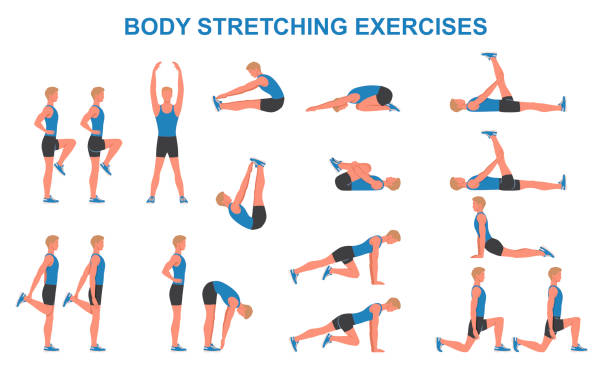Stretching isn’t just for athletes or yoga lovers—it’s a simple yet powerful habit that every man should add to his daily routine. Whether you hit the gym, spend hours at a desk, or just want to move with less pain and more ease, it offers real benefits. It can boost flexibility, improve posture, reduce stress, and even lower your risk of injury.
In this post, we’ll break down the benefits of stretching for men, offer tips on how to get started, and explain why making time to stretch each day can lead to a healthier, more active life.
Why Stretching Matters for Men
Many men focus on building muscle and boosting endurance, but flexibility often gets overlooked. Tight muscles can limit your range of motion, making everyday tasks and workouts harder. Over time, this can lead to injuries, bad posture, and long-term pain.
Adding it to your routine can help:
- Improve blood flow
- Increase flexibility
- Support joint health
- Lower the risk of injury
- Boost performance during workouts
It isn’t just a bonus—it’s a key part of any balanced fitness plan. Making it a regular habit can help you move better, feel better, and stay active longer.

Top Benefits of Stretching for Men
Let’s take a closer look at how stretching can benefit both your body and your mind. This simple practice does more than loosen muscles—it can boost your overall well-being in powerful ways.
1. Boosts Flexibility and Range of Motion
As men get older, it’s normal for muscles and joints to become stiffer. Regular stretching helps keep your body loose, flexible, and ready for action. Improved flexibility leads to:
- Better performance during sports and workouts
- Easier movement in everyday activities
- A lower risk of sprains, strains, and other injuries
Doing dynamic stretches before exercise and static stretches afterward can help protect your flexibility and keep you moving with ease as you age.
2. Improves Posture and Reduces Pain
Many men spend long hours sitting—whether it’s at a desk, behind the wheel, or on the couch. This can lead to tight muscles and poor posture, especially in the neck, shoulders, back, and hips.
Regular stretching helps:
- Loosen tight hip flexors
- Open up the chest and shoulders
- Ease tension in the lower back
Improving your posture not only reduces pain but also helps you stand taller and feel more confident every day.
3. Supports Strength Training Goals
You might think stretching has nothing to do with strength—but the truth is, they work best together. When you stretch regularly, you support your strength training goals. It helps:
- Improve muscle recovery after workouts
- Prevent tightness that can slow down strength gains
- Increase range of motion for lifts like squats and bench presses
Flexible muscles can grow stronger, faster, and with less risk of injury. According to Harvard Health, it also helps reduce soreness and improves joint alignment, making your workouts safer and more effective.
4. Reduces Risk of Injury
Tight muscles are more likely to pull, strain, or tear. It helps prevent this by boosting blood flow and getting your body ready to move. With regular stretching, you can:
- Warm up safely before a workout
- Recover faster after exercise
- Stay injury-free during daily tasks and routines
Just a few minutes of stretching each day can help protect you from painful injuries—and save you from weeks of recovery time.
5. Boosts Circulation and Energy
It helps improve circulation by getting your blood moving more freely through your body. Better blood flow delivers more oxygen to your muscles and organs, which can help you feel more awake, alert, and refreshed.
A quick stretch in the morning or after sitting for a long time can give you a natural energy boost—no coffee needed.
6. Promotes Mental Wellness
It isn’t just good for your body—it also helps calm your mind. When you pair stretching with deep breathing, it lowers stress hormones and encourages relaxation.
This simple habit can help with:
- Reducing feelings of anxiety
- Improving the quality of your sleep
- Enhancing focus and mental clarity
Taking a few minutes to stretch can be the perfect way to pause, reset, and recharge during a busy day.

Best Types of Stretches for Men
Not all stretches work the same way. Each type has a different purpose. Here’s a quick breakdown:
Dynamic Stretching (Before Exercise)
These active movements help warm up your muscles and prepare your body for exercise:
- Leg swings
- Arm circles
- Walking lunges
- Torso twists
Purpose: These stretches increase blood flow, loosen up your muscles, and reduce the risk of injury by getting your body ready for movement.
Static Stretching (After Exercise or Daily)
These stretches involve longer holds that focus on lengthening your muscles:
- Hamstring stretch
- Hip flexor stretch
- Shoulder stretch
- Calf stretch
Purpose: These static stretches improve flexibility, help reduce muscle soreness, and support recovery by allowing your muscles to relax and lengthen.
Daily Stretching Routine for Men
Here’s a simple 10-minute full-body stretching routine you can do daily, whether in the morning or after a workout:
Morning or Post-Workout:
- Neck Rolls – 30 seconds
- Arm Cross-Body Stretch – 30 seconds per arm
- Standing Quad Stretch – 30 seconds per leg
- Hamstring Stretch (Seated or Standing) – 30 seconds per leg
- Hip Flexor Lunge Stretch – 30 seconds per side
- Cat-Cow Stretch (Spine) – 1 minute
- Child’s Pose – 1 minute
Tip: Remember to breathe deeply during each stretch and avoid forcing your body into any position. Flexibility improves gradually, so stay consistent and patient.
Common Mistakes Men Make When Stretching
To get the most out of your stretching routine, avoid these common mistakes:
- Skipping the warm-up: Never stretch cold muscles. Start with a few jumping jacks or arm swings to get your body moving before you stretch.
- Holding your breath: Remember to breathe deeply throughout each stretch. Deep breathing helps relax your muscles and improves flexibility.
- Bouncing during stretches: Avoid bouncing, as it can strain your muscles and lead to injury. Hold each stretch steadily and gently.
- Not stretching regularly: Flexibility is built over time. Aim to stretch at least 3–5 days a week to see consistent progress.
Stretching for Specific Goals
Stretching for Muscle Growth
Men focused on building muscle can benefit from active stretching after their workouts. It helps lengthen the muscles, which aids in recovery and reduces tightness. Over time, this practice can support muscle growth by improving flexibility and promoting better circulation.
Stretching for Sports Performance
Sports like basketball, golf, and running require your body to move through a full range of motion. Stretching before and after these activities can enhance your performance by improving flexibility and joint mobility. It also helps reduce the risk of common injuries, such as sprains or strains, by preparing your muscles and joints for the physical demands of the sport.
Stretching for Back Pain Relief
Lower back pain is a common issue for many men. Incorporating daily hip and hamstring stretches can help relieve pressure on the spine and reduce discomfort. These stretches improve flexibility and promote better alignment, which can lead to less pain and more comfort throughout the day.
The Mayo Clinic suggests that regular stretching can be an effective way to ease back pain and strengthen the muscles that support the spine.
How to Make Stretching a Habit
Starting a stretching routine is simple, but staying consistent can be challenging. Here are a few tips to help you stick with it:
- Schedule it like a workout: Treat stretching as an important part of your fitness routine by setting aside specific times each day.
- Pair it with an existing habit: Link stretching to something you already do, like after brushing your teeth or right after your shower.
- Use a timer or app: Track your progress with a timer or fitness app to stay on track and make stretching a habit.
- Stretch with a friend or join a class: Having a partner or group for motivation can make it more fun and help you stay accountable.
- Reward yourself: Celebrate your consistency by rewarding yourself when you meet your stretching goals.
Remember, the key is to start small and gradually build the habit, making stretching a regular part of your day.

Frequently Asked Questions
How long should I stretch each day?
Start with 5–10 minutes a day. Focus on the muscles you use most often.
Is it bad to stretch cold muscles?
Yes. Always warm up your body first to prevent injuries.
Can stretching replace a workout?
No, but it’s a great complement to strength training, cardio, and rest.
Final Thoughts: Stretching Is Strength
Stretching isn’t only about improving flexibility—it’s a powerful tool that helps build resilience, reduce pain, and increase strength. For men of all ages, it is one of the smartest and most effective additions to any wellness routine.
Don’t wait until you’re feeling stiff or dealing with an injury to start stretching. By incorporating it into your daily routine now, you’ll experience improvements in your workouts, posture, and energy levels. Start today and feel the positive difference in how your body moves and feels.
Ready to get started?
Drop a comment below and let us know your favorite stretch or what your current routine looks like! Need help building a stretching plan? We’d love to help—just ask!
👉 Stay strong, stay flexible, and take care of your body—it’s the only one you’ve got.

